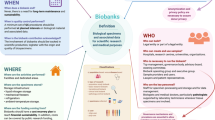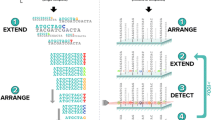Abstract
The International Standards for Cytogenomic Arrays (ISCA) Consortium is a worldwide collaborative effort dedicated to optimizing patient care by improving the quality of chromosomal microarray testing. The primary effort of the ISCA Consortium has been the development of a database of copy number variants (CNVs) identified during the course of clinical microarray testing. This database is a powerful resource for clinicians, laboratories, and researchers, and can be utilized for a variety of applications, such as facilitating standardized interpretations of certain CNVs across laboratories or providing phenotypic information for counseling purposes when published data is sparse. A recognized limitation to the clinical utility of this database, however, is the quality of clinical information available for each patient. Clinical genetic counselors are uniquely suited to facilitate the communication of this information to the laboratory by virtue of their existing clinical responsibilities, case management skills, and appreciation of the evolving nature of scientific knowledge. We intend to highlight the critical role that genetic counselors play in ensuring optimal patient care through contributing to the clinical utility of the ISCA Consortium’s database, as well as the quality of individual patient microarray reports provided by contributing laboratories. Current tools, paper and electronic forms, created to maximize this collaboration are shared. In addition to making a professional commitment to providing complete clinical information, genetic counselors are invited to become ISCA members and to become involved in the discussions and initiatives within the Consortium.
Similar content being viewed by others
References
American College of Obstetricians and Cynecologists (ACOG) Committee. (2009). Array comparative genomic hybridization in prenatal diagnosis. ACOG Committee Opinion No. 446. Obstetrics and Gynecology, 114, 1161–1163.
Bale, S., Devisscher, M., Van Criekinge, W., Rehm, H. L., Decouttere, F., Nussbaum, R., et al. (2011). MutaDATABASE: a centralized and standardized DNA variation database. Nature Biotechnology, 29(2), 117–118.
Bejjani, B. A., & Shaffer, L. G. (2008). Clinical utility of contemporary molecular cytogenetics. Annual Review of Genomics and Human Genetics, 9, 71–86.
Berg, J. S., Khoury, M. J., & Evans, J. P. (2011). Deploying whole genome sequencing in clinical practice and public health: meeting the challenge one bin at a time. Genetics in Medicine, 13(6), 499–504.
Chen, B., & Greene, C. (2010). Promoting quality of genetic testing with guidelines for good laboratory practices. Molecular Genetics and Metabolism, 99, 238–243.
Chen, B., Gagnon, M., Shahangian, S., Anderson, N. L., Howerton, D. A., & Boone, D. J. (2009). Centers for disease control and prevention, good laboratory practices for molecular genetic testing for heritable diseases and conditions. MMWR Recommendations and Reports, 58(RR-6), 1–37.
Church, D. M., Lappalainen, I., Sneddon, T. P., Hinton, J., Maguire, M., Lopez, J., et al. (2010). Public data archives for genomic structural variation. Nature Genetics, 42(10), 813–814.
Coppinger, J., Alliman, S., Lamb, A. N., Torchia, B. S., Bejjani, B. A., & Shaffer, L. G. (2009). Whole-genome microarray analysis in prenatal specimens identifies clinically significant chromosome alterations without increase in results of unclear significance compared to targeted microarray. Prenatal Diagnosis, 29(12), 1156–1166.
Das, S., Bale, S. J., & Ledbetter, D. H. (2008). Molecular genetic testing for ultra rare diseases: models for translation from the research laboratory to the CLIA-certified diagnostic laboratory. Genetics in Medicine, 10(5), 332–336.
Falk, M. J., Wang, H., & Traboulsi, E. I. (2011). Cohen syndrome. In R. A. Pagon, T. D. Bird, C. R. Dolan, & K. Stephens (Eds.), GeneReviews [Internet]. Seattle: University of Washington. 1993–2006 Aug 29 [updated 2011 Mar 10], accessed 9/19/2011.
Faucett, W. A., Hart, S., Pagon, R., Neall, L., & Spinella, G. (2008). A model program to increase translation of rare disease genetic tests: collaboration, education, and test translation program. Genetics in Medicine, 10(5), 343–348.
Gkoutos, G. V., Mungall, C., Dolken, S., Ashburner, M., Lewis, S., Hancock, J., et al. (2009). Entity/quality-based logical definitions for the human skeletal phenome using PATO. Conference Proceedings—IEEE Engineering in Medicine and Biology Society, 2009, 7069–7072.
Goh, C. S., Gianoulis, T. A., Liu, Y., Li, J., Paccanaro, A., Lussier, Y. A., et al. (2006). Integration of curated databases to identify genotype-phenotype associations. BMC Genomics, 7, 257.
Groth, P., Weiss, B., Pohlenz, H. D., & Leser, U. (2008). Mining phenotypes for gene function prediction. BMC Bioinformatics, 9, 136.
Hsu, L. Y., Yu, M., Neu, R. L., Van Dyke, D. L., Benn, P. A., Bradshaw, C. L., et al. (1997). Rare trisomy mosaicism diagnosed in amniocytes, involving an autosome other than chromosomes 13, 18, 20, and 21: karyotype/phenotype correlations. Prenatal Diagnosis, 17(3), 201–242.
Kaminsky, E. B., Kaul, V., Paschall, J., Church, D. M., Bunke, B., Kunig, D., et al. (2011). An evidence-based approach to establish the functional and clinical significance of copy number variants in intellectual and developmental disabilities. Genetics in Medicine, 13(9), 777–784.
Kearney, H. M., Thorland, E. C., Brown, K. K., Quintero-Rivera, F., South, S. T., Working Group of the American College of Medical Genetics Laboratory Quality Assurance Committee., et al. (2011). American College of Medical Genetics standards and guidelines for interpretation and reporting of postnatal constitutional copy number variants. Genetics in Medicine, 13(7), 680–685.
Kohler, S., Schulz, M. H., Krawitz, P., Bauer, S., Dolken, S., Ott, C. E., et al. (2009). Clinical diagnostics in human genetics with semantic similarity searches in ontologies. American Journal of Human Genetics, 85(4), 457–464.
Manning, M., Hudgins, L., & Professional Practice and Guidelines Committee. (2010). Array-based technology and recommendations for utilization in medical genetics practice for detection of chromosomal abnormalities. Genetics in Medicine, 12(11), 742–745.
Maya, I., Davidov, B., Gershovitz, L., Zalzstein, Y., Taub, E., Coppinger, J., et al. (2010). Diagnostic utility of array-based comparative genomic hybridization (aCGH) in a prenatal setting. Prenatal Diagnosis, 30(12–13), 1131–1137.
Miller, D. T., Adam, M. P., Aradhya, S., Biesecker, L. G., Brothman, A. R., Carter, N. P., et al. (2010). Consensus statement: chromosomal microarray is a first-tier clinical diagnostic test for individuals with developmental disabilities or congenital anomalies. American Journal of Human Genetics, 86, 749–764.
Miller, C. E., Krautscheid, P., Baldwin, E. E., LaGrave, D., Openshaw, A., Hart, K., et al. (2011). Value of genetic counselors in the laboratory. White paper. ARUP Laboratories. www.aruplab.com
Oliveira, J., Dias, C., Redeker, E., Costa, E., Silva, J., Reis Lima, M., et al. (2010). Development of NIPBL Locus-Specific Database Using LOVD: from novel mutations to further genotype–phenotype correlations in Cornelia de Lange syndrome. Human Mutation, 31(11), 1216–1222.
Perez-Iratxeta, C., Bork, P., & Andrade, M. A. (2002). Association of genes to genetically inherited diseases using data mining. Nature Genetics, 31, 316–319.
Riggs, E. R., Church, D. M., Hanson, K., Horner, V. L., Kaminsky, E. B., Kuhn, R. M., et al. (2011). Towards an evidence-based process for the clinical interpretation of copy number variation. Clinical Genetics. doi:10.1111/j.1399-0004.2011.01818.x.
Riggs, E. R., Jackson, L., Miller, D. T., & Van Vooren, S. (2012). Phenotypic information in genomic variant databases enhances clinical care and research: the international standards for cytogenomic arrays consortium experience. Human Mutation, 00, 1–10.
Robinson, P. N., & Mundlos, S. (2010). The human phenotype ontology. Clinical Genetics, 77(6), 525–534.
Robinson, P. N., Kohler, S., Bauer, S., Seelow, D., Horn, D., & Mundlos, S. (2008). The human phenotype ontology: a tool for annotating and analyzing human hereditary disease. American Journal of Human Genetics, 83(5), 610–615.
Sebold, C., Graham, L., & McWalter, K. (2009). Presented abstracts from the Twenty-Eighth Annual Education Conference of the National Society of Genetic Counselors. Journal of Genetic Counseling, 18(6), 669.
Shaffer, L. G., Ledbetter, D. H., & Lupski, J. R. (2006). Molecular cytogenetics of contiguous gene syndromes: mechanisms and consequences of gene dosage imbalance. In C. R. Scriver, et al. MMBID Online, http://genetics.accessmedicine.com. McGraw-Hill, New York (accessed 10/21/2011).
Slavotinek, A. M. (2008). Novel microdeletion syndromes detected by chromosome microarrays. Human Genetics, 124(1), 1–17.
The Clinical Laboratory Improvement Amendments (CLIA) regulations; laboratory requirements, 42 C.F.R. Part 493 (2004). Available at http://www.cdc.gov/clia/regs/toc.aspx
Tsuchiya, K. D., Shaffer, L. G., Aradhya, S., Gastier-Foster, J. M., Patel, A., Rudd, M. K., et al. (2009). Variability in interpreting and reporting copy number changes detected by array-based technology in clinical laboratories. Genetics in Medicine, 11, 866–873.
Tuffery-Giraud, S., Beroud, C., Leturcq, F., Ben Yaou, R., Hamroun, D., Michel-Calemard, L., et al. (2009). Genotype-phenotype analysis in 2,405 patients with a dystrophinopathy using the UMD-DMD database: a model of nationwide knowledgebase. Human Mutation, 30(6), 934–945.
Warburton, D. (1991). De novo balanced chromosome rearrangements and extra marker chromosomes identified at prenatal diagnosis: clinical significance and distribution of breakpoints. American Journal of Human Genetics, 49, 995–1013.
Wong, K. K., deLeeuw, R. J., Dosanjh, N. S., Kimm, L. R., Cheng, Z., Horsman, D. E., et al. (2007). A comprehensive analysis of common copy-number variations in the human genome. American Journal of Human Genetics, 80(1), 91–104.
Zierhut, H., & Austin, J. (2011). How inclusion of genetic counselors on the research team can benefit translational science. Science Translational Medicine, 3(74), 74cm7.
Acknowledgements
This work was supported by NIH Grant HD064525.
Author information
Authors and Affiliations
Corresponding author
Rights and permissions
About this article
Cite this article
Wain, K.E., Riggs, E., Hanson, K. et al. The Laboratory-Clinician Team: A Professional Call to Action to Improve Communication and Collaboration for Optimal Patient Care in Chromosomal Microarray Testing. J Genet Counsel 21, 631–637 (2012). https://doi.org/10.1007/s10897-012-9507-9
Received:
Accepted:
Published:
Issue Date:
DOI: https://doi.org/10.1007/s10897-012-9507-9




